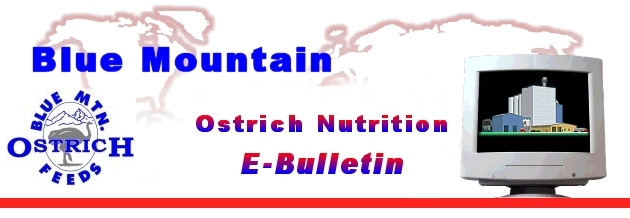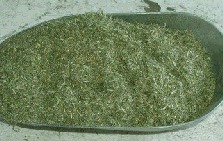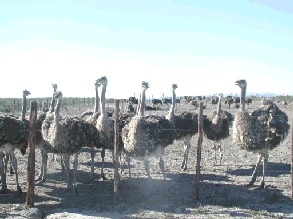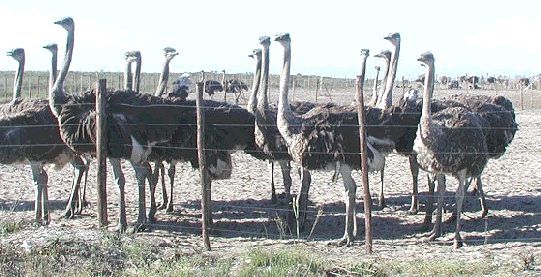

February 5, 2002
Bulletin #76
Table of contents:
Bulletin of the Month
Gearing Up For Ostrich Production!
By: Fiona Benson, Blue Mountain International
Daryl Holle, Blue Mountain Feeds, Inc.
Our e-mail address
Subscribe – Unsubscribe information
Bulletin of the Month
Gearing Up For Ostrich Production!
With Ostrich a new Livestock Meat Production industry, the knowledge and understanding of farming the birds on a Production scale for profit is very limited. Much information is published that is based on South African principals and/or from limited experience by those who have not had the privilege to see what we would class as a “healthy” ostrich. It has therefore been our experience that conclusions are being reached from an incorrect base that all too often is taking the industry in a backwards direction.
The purpose of this article is to discuss several myths or information that is commonly published that our research has clearly shown to be incorrect, misleading and/or against the principals of Productive livestock management.
Breeding Season
To obtain optimum Production from any breeding animal, it is necessary to avoid anything that upsets the normal pattern. The South African tradition has been to separate the breeders in January or February (equivalent to July or August in the Northern Hemisphere). The birds would then be plucked and all too often placed on a diet very low in nutrients. Some of reasons given for separating the birds have been given as:
1. To Stop Breeding
2. End of season chicks are weaker and not needed
3. Poor performance of chicks in the winter months
4. Plucking the Birds
5. Hens need more calcium in their diet than males
Let’s discuss the lack of commercial and Production sense in this reasoning.
To Stop Breeding:
To interfere with any Production animal’s normal Production cycle will impact on the Production potential of that animal. It only makes commercial sense to achieve the optimum Production we can.
Our customer’s major complaint at this time is inconsistency in supply. We have a wonderful bird with great Production potential, why stop Production artificially? Doing so will impact on Production in the future and the Ostrich has potentially a long Production life…apart from accident, the main reason for shortening the Production life will come from a culling program designed to improve the genetics of the herd. How can one identify the superior Production genetics if there is artificial control of the Production season?
Ostrich Breeder birds have a complex “bonding” ritual and an important part of this bonding is the interaction between the members of a breeding group (pairs, trios, quads) that takes place during the off season. If it is necessary to change partnerships as a result of culling or changing breeding partnerships for genetic purposes, then this should take place at the end of the breeding season. That provides the off season period for the new partnerships to develop their bond prior to the start of the new season.
Weaker Chicks at end of Season:
One reason given for forcibly stopping the breeding cycle relate to weaker chicks at the end of the season, chick’s poor performance through the winter months and/or increased costs of maintaining chicks through the winter months.
The answers that makes commercial sense provide solutions to the problem:
a. Nutritional Support - The weaker chicks are a direct symptom of inadequate breeder nutrition…the birds are not receiving adequate nutrients to support high levels of quality egg Production to sustain them for a full breeder season. A progressive producer will be seeking methods to ensure that their birds are nutritionally supported to maintain high levels of Production for a full season. Given the Production potential of Ostrich compared to their limited annual feed intake, it only takes a few additional chicks per season to cover the additional costs to provide a Productive ration to the breeders, even if that ration is at double the cost of the current rations.
It makes commercial sense to optimize the Production potential of the birds rather than feeding them for an extended period of non-productive time. Additionally, what is the commercial sense of requiring additional breeders requiring additional feed, infrastructure and capital investment when fewer breeders managed correctly can achieve greater levels of Production?
b. Adequate Chick Facilities – Winter difficulties in raising chicks can be overcome by providing the correct infrastructure, even if the costs are a little higher, it makes commercial sense. It is worth remembering that the idea that chicks are difficult or expensive to raise in winter came from South Africa where winter weather is better than summers in many countries that are now raising ostrich.
Worthy of note is the fact that the Blue Mountain Field Trials for weight gains were carried out in an area that has extended periods below freezing during the winter months and wind chill factors that reached –50degrees Fahrenheit. Providing birds with warm water, heated to at least 70 degrees F. (20degrees centigrade), will ensure good feed intake during the cold weather.
The farmer who carried out the trials said that he did so as many people were telling him their chicks did not grow in the winter. As he knew that his continued to grow well, he set out to prove that fact. When we visited him several years later he told us that he now believes that the chicks grow better in the winter than the hot summers. Time will tell if he is correct in this observation.
Plucking Birds:
Any handling of breeder birds is stressful. Any stress will impact on Production. Whilst the feathers are a marketable product and most beautiful product, it is essential to examine the commercial viability of feather revenue vs. lost Production. Remember this is carried out at the end of a breeding season when the birds are at their lowest point with regards to nutrient reserves and condition, if they have been productive during the season.
Hens require more Calcium than Males:
We hear this comment repeatedly and the experience of Blue Mountain is quite the reverse. To prove this fact we can relate a very specific example: An entire flock of Ostrich Breeder birds were showing symptoms of a severe deficiency of calcium. Most breeders at this farm had stiff joints (both Males and Females) and the hens were laying chalky eggs. After a while, there was no breeding activity whatsoever and the condition continued to progress until some of the breeder birds sat down and could no longer get up to stand. The most interesting part of this severe Calcium deficiency was that THE MALES went down FIRST and were affected most severely. The hens were still walking around, laying chalky eggs, but most of the Males were down on the ground and could not get up to stand. There was a severe imbalance in the feed of Trace Minerals and Vitamins and a poor source of Calcium was being used in the feed causing all these problems. Fixing those problems got all the birds back to normal within two weeks.
Calcium requires an adequate level of Phosphorus, Magnesium, Trace Minerals, and Vitamins to be properly utilized and metabolized within the bird. If these elements are in place in balanced proportions within the feed, both Male and Female can handle them well by taking what they need and excreting the excess in the feces and urine.
Bare in mind at all times that the market demands a sustainable supply of Ostrich. As an industry, we can only address this problem through ensuring we achieve the maximum length of Production season possible.
PRODUCTION Nutrition:
For the past few years Blue Mountain has endeavored to help the industry understand Ostrich Nutrition in a Production environment. Yet we still see a number of support specialists advocating practices that make very little nutritional sense, especially relating to Production. Remember also that an animal has to be in optimum health to achieve optimum Production. Modern livestock nutritional technology has eliminated most all health problems associated with livestock Production if the full program is followed and high standards of Feed Management are practiced.
There are a couple of things to remember when discussing Production nutrition, especially as it applies to Ostrich:
a. For their body weight Ostrich feed consumption is very limited and therefore their rations need to be extremely dense. This requires a high degree of precision and what may seem like minor errors or omissions is very significant to the Ostrich
b. The words of Daryl Holle “Ostrich respond better to good nutrition than any other specie I have worked with, and that makes it fun”.
c. EVERYTHING that goes through the mouth during the day contributes to the TOTAL DAILY INTAKE of nutrients.
Therefore to achieve optimum Production, all components of the daily diet should be included as a complete ration that is mixed with absolute accuracy to ensure a balanced intake of all components. It is not necessary for this ration to be pelleted. If fed ground, it is essential that all particle sizes should be the same to ensure even intake.
Production rations must contain ingredients from the following feed groups:
 |
Figure 1 - Farm Mixed Complete Ration

It is not necessary for rations to be pelleted, it is totally acceptable to feed ground rations. However, the rations must be mixed with the similar particle sizes to ensure even intake by the birds. Figure 1 is an illustration of a complete ration milled and mixed on farm.
As a result of many commercial rations being produced with a high grain content and/or very poor ingredient use, advice has been given to add quality lucerne as a supplement to the rations. While this may assist in bird health and survival, it is not conducive to Production. The solution is to work at achieving rations that are correct and feed as a complete ration. As can be seen in Figure 1, the lucerne is a critical part of the complete Production ration and provides the fibre in the correct proportions and from the correct sources.
Lucerne is a critical part of any ration for Ostrich as it provides many other valuable nutrients to a complete ration. It is also a major contributor to the calcium content of a ration and therefore must be fed in controlled amounts and in balance to the rest of the ingredients in the ration. If not, there is significant danger of incorrect calcium and other mineral balance, and throwing out the delicate calcium/phosphorous ratios. Quality lucerne with a high protein content is also a cost effective source of protein in the ration and can result in reduced inclusion levels of the more expensive Soyameal. At all times it is essential to watch the ratios of the different ingredients to ensure that there is not an excess of any one ingredient type over another.
In the past I have read articles written by support specialists recommending to farmers that in cold weather the farmer may add 500gs of barley, 400gs of additional lucerne or similar. This may work for cattle, but this is very DANGEROUS advice for Ostrich. When you consider that these figures represent around 25% of the total daily intake of an adult ostrich (even higher percentage of a young bird), one can recognize the dangers of such advice...especially as there are many different rations being fed by different farmers and most farmers have no idea of the proportion of other ingredients in a ration.
The more serious dangers of this advice is that this dilutes a ration and throws the delicate vitamin and mineral balance seriously out of balance, and can result in mineral interferences that can make certain nutrients unavailable to the birds even though they may have been supplied in the ration correctly.
If additional nutrients are required in bad weather, the complete ration should be fed at increased amounts...NEVER just add a single ingredient, such as Maize and/or Lucerne.
Figure 2 - 120 Days (18 weeks) Winter Chicks

Conclusion: It is worth remembering that if a poultry farmer is a single day late in meeting the weights for his chickens, it can be the difference between profit and loss. That finishing time has been reduced from over 60 days to 42 days. Pig Production has reduced finishing time to 90 days…we can list the significant improvements in all traditional livestock specie Production statistics.
The chicks in Figure 2 are African Blacks at 4 months of age. Figure 3 is the same batch 8 weeks later. They were fed on complete rations as illustrated in Figure 1, with NO supplementation. They entered the feedlots at 3mths of age and experienced heavy rainfall during the whole period…the worst rainfalls in the region for 44 years.
In Ostrich we have the MOST EFFICIENT CONVERTER OF FEED TO MEAT. It is time for the Industry to recognize the Production potential of Ostrich and all the factors that influence Production. I trust that this article has provided some pointers where general advice remains against the principals of commercial livestock Production. It is now time to unlock the potential of these birds to become a professional livestock Production industry.
Figure 3: Same Chicks 190 Days (27weeks)

Click to return to Contents Page
 |
Contact Information:
If you have any Bulletin Topics you would like us to consider for publication in a future E-Bulletin, e-mail your information to
. We are always interested in hearing your ideas about the value of this E-Bulletin, or whether you have any problems viewing this document.
If you would like to discontinue your subscription to this E-Bulletin, or if you have additional e-mail addresses to add to our subscriber list, please visit the following page on our website and use the automated form to “subscribe” or “unsubscribe”: www.blue-mountain.net/feed/bulletin.htm
Also check out our web site at www.blue-mountain.net for feature articles addressing Ostrich Nutrition, Feeding Management, and Ostrich Farm Management..
Click to return to Contents Page
 |
Blue Mountain Ostrich Nutrition E-Bulletin © February 2002
Return to Bulletin Menu